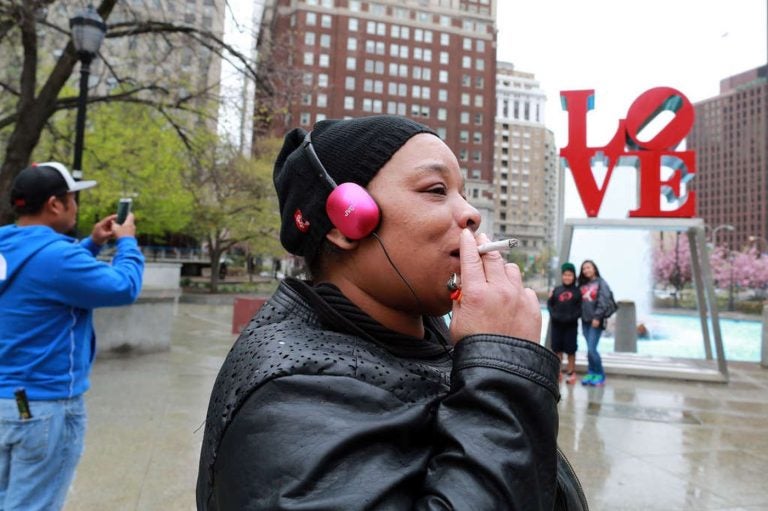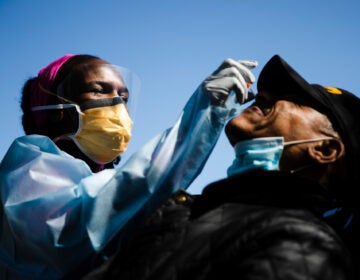Black and Hispanic Americans have a harder time quitting cigarettes. Will this Penn study find a way to help?
Black and Hispanic Americans are less likely to smoke cigarettes than white Americans. Yet once they’ve started, they’re more likely to stay hooked.

A woman smokes a cigarette at JFK Plaza (David Swanson/Philadelphia Inquirer)
Black and Hispanic Americans are less likely to smoke cigarettes than white Americans. Yet once they’ve started, they’re more likely to stay hooked. National data show they successfully quit only about half as often as white smokers.
These communities often have less access to nicotine-replacement therapy and counseling that can help them quit. But experts say that’s only one piece of a much larger issue.
Black and Hispanic Americans, especially those with low income and education levels, often work or live in places without smoke-free laws, said Stella Bialous, an associate professor of social behavioral sciences at the University of California, San Francisco. Being around others who smoke makes it more difficult to quit.
Higher levels of stress experienced by these communities also can make them more likely to turn to cigarettes for the relief nicotine can offer, said David Williams, a public-health professor at Harvard University who studies racial health disparities.
Given such obstacles, what could help these smokers quit? The federal Patient-Centered Outcomes Research Institute has awarded $11 million to a team of researchers, led by the University of Pennsylvania, to answer that question.
The study will include 3,200 smokers who are black, Hispanic, live in a rural area, or have a low income or education level — all groups for whom data show smoking cessation is most challenging. They will be recruited during lung cancer screenings at the University of Pennsylvania Health System in Philadelphia, Geisinger Health System in northeastern and central Pennsylvania, Kaiser Permanente in Southern California, and Henry Ford Health System in Detroit.
Annual lung cancer screenings are recommended for heavy smokers over the age of 55 who currently smoke or have quit within the last 15 years. Many screening programs are required to offer smoking-cessation services to their patients.
“But most are scrambling to figure out what programs to offer,” said Scott Halpern, lead researcher of the study and a professor of medicine at Penn. “It’s entirely unclear what approaches work best among people presenting for lung cancer screening, let alone which work best among underserved populations.”
It’s a missed opportunity, he said. Patients undergoing screening are often more concerned about their health. A study from the University of Texas found lung cancer screening participants are three to four times more likely to quit successfully than other smokers.
Four Approaches
Study participants in each health system will be randomly assigned to one of four interventions to help them quit smoking.
The first group will receive the standard approach employed at lung cancer screenings: Clinicians ask patients about their desire to quit, advise them to quit, and refer them to resources like hotlines or support groups.
It’s a passive system that often puts the burden on patients to follow through on referrals, said Stanton Glantz, director of the UCSF Center for Tobacco Control Research and Education.
The second group will receive the standard approach plus free access to nicotine patches and gum, as well as FDA-approved drugs to help with quitting.
The third group will be referred to support resources, and receive free nicotine-replacement aids and a mobile health app that will text participants personalized reminders of what they will gain by quitting.
The fourth group will receive all those services and will be paid up to $600 for successfully quitting. Previous research has shown financial incentives are one of the most effective strategies to help people quit. Though this approach has an upfront cost, Halpern said, it saves money in the long run by decreasing the likelihood that patients will develop lung cancer or heart disease.
All four interventions will be offered for six months, then researchers will follow up with patients for a year. The trial is set to start in 2020 and end in 2022.
“We’re confident that if we succeed in producing this evidence, health systems and payers will respond,” Halpern said.
Why it may not be so simple
Smoking-cessation experts caution that helping smokers in underserved populations quit is a complex challenge.
A common myth is that paying for nicotine-replacement products will solve the problem, said Glantz, of UCSF. But studies show that gums and patches don’t work well without counseling. In fact, Glantz explained in a 2017 essay for the American Journal of Public Health, many patients end up using them in addition to cigarettes rather than as a replacement.
Counseling is crucial to address the underlying stress that drives people to smoke, said Williams, of Harvard. “You’re looking at a population with fewer alternatives to cope,” he said. “That makes it harder for them to give up that aid.”
The new study will not require patients to undergo counseling, though they can choose to pursue resources provided by clinicians.
Environment is another potential barrier to success, said Bialous, of UCSF. “People who don’t see cigarette ads, who don’t shop in places that sell cigarettes,” she said, “have an easier time quitting.”
Research shows that people of lower income are more likely to live in neighborhoods with high rates of tobacco retailers. In Philadelphia, which has the highest rate of adult smokers among the nation’s 10 largest cities, almost half of all tobacco retailers are located in low-income communities, according to the city Department of Public Health.
That’s no coincidence, Glantz said. “While smoking has come down in the general population, the tobacco industry has been focusing more and more on holding onto people with less education and lower income,” he said. Such efforts have included handing out cigarettes in housing projects, issuing tobacco coupons with food stamps, and fighting attempts at regulation.
Misinformation can also deter those hoping to quit. E-cigarettes are often advertised as quitting aids, but an increasing amount of data show that’s not the case.
The FDA recently moved to restrict e-cigarette sales at most gas stations and convenience stores because it said they were encouraging more youth to start smoking than adults to quit. The agency also announced plans to ban menthol cigarettes, which are disproportionately popular among African Americans.
That may prevent future smokers, Bialous said. But it’s only one side of the issue.
“It’s important to understand how we can eliminate the disparity in quitting, just as we try to eliminate the disparity in starting,” she said.
Philadelphia Media Network is one of 21 news organizations producing Broke in Philly, a collaborative reporting project on solutions to poverty and the city’s push toward economic justice. See all of our reporting at brokeinphilly.org.

WHYY is your source for fact-based, in-depth journalism and information. As a nonprofit organization, we rely on financial support from readers like you. Please give today.




